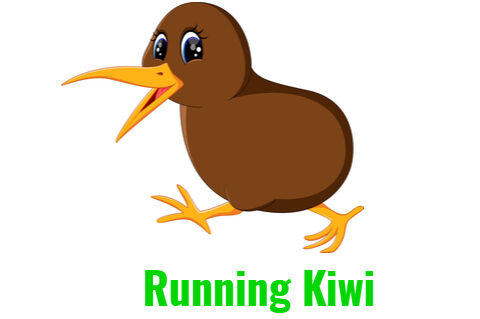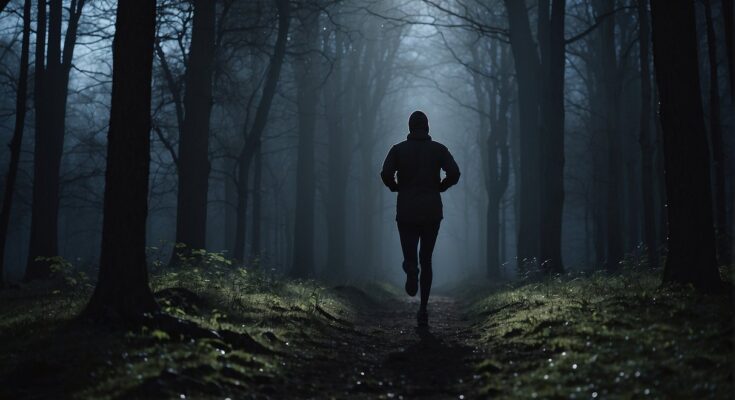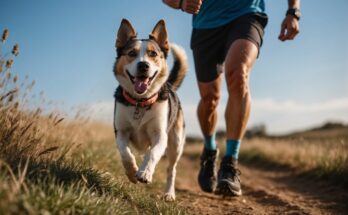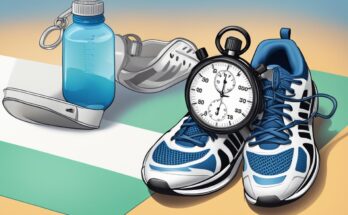Running after the sun sets offers a unique experience compared to daytime jogs. The calm of the evening can create a serene atmosphere for runners, providing a sense of solitude and peace that’s hard to find during the busy daylight hours. With fewer distractions, nighttime runners often report being able to better focus on their pace, breathing, and the rhythm of their steps. While the streets and trails are less crowded, this quiet time can also present an opportunity for introspection and meditation in motion.

However, it’s essential for those who run at night to take extra precautions. Visibility becomes a primary concern, as both runners need to see where they’re going and be seen by others, especially in areas with vehicular traffic. To address this, many nocturnal runners wear reflective clothing and use headlamps or flashlights. Safety measures also include choosing well-lit routes, being aware of one’s surroundings, and, if possible, running with a partner or a group. Despite the challenges, the allure of nighttime running continues to draw enthusiasts who find the night to be a refreshing alternative to daylight running.
There are several physiological benefits to running in the cooler, nighttime temperatures as well. The body can perform more efficiently without the strain of excessive heat, which can lead to improved endurance and potentially faster times. Runners might appreciate the respite from the sun’s harsh rays, decreasing the risk of heat exhaustion and sunburn. Moreover, the act of running itself can prove to be a helpful tool in winding down and preparing for a good night’s sleep, as long as it’s timed appropriately with one’s personal sleep cycle.
Benefits of Nighttime Running
Running after dark can offer distinct advantages for both the body and mind. Many runners find that cooler temperatures at night lead to a more comfortable experience, as the heat and humidity typically drop, making it easier for the body to regulate its temperature. This can result in a more efficient workout where energy is conserved, potentially improving performance.
De-stressing is another significant benefit of nighttime running. After a long day, running in the evening can serve as a mental release, allowing individuals to process the day’s events and reduce stress levels. The act of running triggers the release of endorphins, contributing to a sense of calm and well-being.
A benefit often overlooked is the potential for a better night’s rest. Evening exercise can help some individuals unwind and prepare for sleep, although it’s important to note that others may need to finish their run a few hours before bedtime to avoid sleep disruption.
| Benefits | Nighttime Running |
|---|---|
| Cooler Temperatures | More comfortable running conditions |
| Fewer Distractions | Quieter streets, less traffic |
| Energy Conservation | Improved performance |
| De-Stress | Reduced stress, mental clarity |
Moreover, night runners often experience fewer distractions. The streets are usually less crowded, there’s less vehicular traffic, and the overall pace of the world slows down, providing a more peaceful environment to focus on the run.
It is essential for runners to consider safety and visibility when running at night by wearing reflective gear and perhaps running in well-lit areas. They should also be mindful of their personal comfort and safety, listening to their body’s response to evening exercise.
Preparing for a Night Run
Proper preparation for a nighttime run is essential for ensuring safety and comfort. Runners should focus on visibility to motorists and the ability to navigate varying conditions.
Safety Gear
One should invest in a running headlamp or a headlight to illuminate their path and remain visible. A good choice is a headlamp that is both lightweight and bright enough to light up the road or trail ahead. Wearing reflective clothing is crucial for visibility; this includes vests, arm and leg bands, or reflective strips on shoes. Carrying a phone with a location-sharing app can alert contacts in case of an emergency. Additionally, consider setting a safety alarm or downloading an app that can send distress signals when necessary.
| Safety Gear | Description |
|---|---|
| Headlamp | A lightweight yet bright headlamp enhances visibility |
| Reflective Clothing | Clothing items that reflect light to alert motorists |
| Phone | To use for emergency calls or location-sharing apps |
| Alarm | Safety alarms for alerting in case of distress |
Choosing the Right Gear
Selecting appropriate gear can make a significant difference. Runners should opt for shoes like the Brooks Ghost 14 which provide comfort and support for varying terrains. Comfort is key, so gear should be breathable and waterproof if conditions suggest rain. Layering is recommended as temperatures can drop after sunset. Accessories should include water bottles or hydration packs, especially for longer distances to avoid dehydration.
| Gear Type | Suggested Item | Benefits |
|---|---|---|
| Shoes | Brooks Ghost 14 | Comfort and support for varied terrains |
| Clothing | Waterproof and breathable layers | Adjusts to changing temperature and weather conditions |
Safety Considerations and Tips

When running at night, staying safe is of paramount importance. Runners need to ensure they are visible, aware of their surroundings, adhere to traffic rules, and choose their routes strategically.
Visibility and Alertness
Runners should make themselves highly visible to others by wearing reflective clothing and using lights. This can include headlamps, light-up armbands, or flashing shoe lights. It’s also vital for a runner to remain alert. They should avoid headphones to keep their ears open to potential dangers and always be aware of their surroundings.
- Reflective Gear: Bright, reflective vests, jackets, or stripes on clothing.
- Lights: Flashing armbands, headlamps, or rear safety lights.
Traffic Rules and Awareness
Adhering to traffic rules is critical for safety during nighttime runs. Runners should always face oncoming traffic if running on the road and cross streets at designated crossings. Being aware of traffic patterns and peak hours through research can help runners choose safer times to run.
- Facing Traffic: Run on the left side of the road to see and be seen by oncoming drivers.
- Crossing Safely: Only cross at crosswalks or traffic signals; never assume a driver sees you.
Running Route Strategies
Choosing a route is a key safety consideration for night runners. They should know their route well, sticking to well-lit areas and avoiding isolated paths. Planning a route with public areas and emergency phone stations can provide additional safety.
- Well-Lit Paths: Choose paths with adequate streetlights or public illumination.
- Familiar Routes: Select routes pre-run during the day to ensure the path’s safety.
By following these guidelines, nighttime runners can improve their safety and enjoy their runs with greater peace of mind.
Running Performance and Health

Optimizing performance and health in nighttime running revolves around structured workout routines, proper nutrition and hydration, and adequate recovery and rest.
Workout Routines
Nighttime runners should tailor their training plans to improve strength and performance. A sample week may include:
- Monday: Speed intervals (1 mile warm-up, 8x400m fast with 400m recovery jogs, 1 mile cool down)
- Wednesday: Tempo run (1 mile warm-up, 5 miles at a challenging but sustainable pace, 1 mile cool down)
- Friday: Long, slow distance run (10-15 miles at an easy pace to enhance endurance)
Strength workouts, such as squats and lunges, should be performed twice a week to enhance muscle fitness and support running mechanics.
Diet and Hydration
To ensure energy levels are optimized for nighttime running, one must focus on:
- Carbohydrates: Consume a balanced meal with complex carbohydrates 2-3 hours before running to fuel the workout. Pre-Run Meal Carbohydrate Source Rice and chicken Brown rice Pasta dish Whole grain pasta Quinoa salad Quinoa
- Hydration: Drink water throughout the day, with an emphasis on the hours leading up to the workout to ensure proper blood flow and cooling. Ingest electrolytes post-run to replenish lost minerals.
Recovery and Rest
Recovery plays a crucial role in a runner’s performance and health. They must:
- Get 7-9 hours of sleep per night to allow for muscle repair and recovery, which can also help regularize sleep patterns altered by nighttime activity.
- Incorporate active recovery days with light activities such as walking or yoga to promote blood flow and aid in the removal of lactic acid from the muscles.
- Utilize rest days to let the body fully recover from the exertion of the training week, which helps prevent overuse injuries and maintains a runner’s long-term energy levels and performance.
Psychological Benefits and Mental Health

Running at night offers unique psychological advantages. It can be an effective way to improve mental health by providing stress relief and enhancing mental clarity.
Stress Relief and Meditation
Running after dark transforms into a form of moving meditation, as it allows individuals to de-stress by focusing on their physical sensations and breathing. The rhythmic patter of one’s footsteps and the regulated breathing required during a run can align closely with meditative practices, providing:
- A sense of peace and solitude
- Reduced levels of the stress hormone cortisol
- An increase in endorphins, often referred to as the “runner’s high”
Meditation during a run is bolstered by the quiet and calm of the nighttime environment, allowing runners to turn inward and find a meditative state with fewer distractions.
Mental Clarity and Focus
Nighttime running can enhance mental clarity and focus. The reduction in sensory input after dark means less distraction, which enables runners to concentrate on their thoughts effectively. Key benefits include:
- Improved problem-solving skills: Running provides the opportunity to think through issues without interruptions.
- Sharper focus: Regular running is known to increase levels of brain-derived neurotrophic factor (BDNF), a protein that supports cognitive function.
Furthermore, the increased oxygen flow to the brain during physical activity can lead to better mental acuity. Additionally, as running can potentially improve sleep quality, it indirectly contributes to greater mental sharpness and cognitive health.
Gear and Equipment Recommendations

When running after dark, safety and visibility should be a runner’s top priority. Proper gear and equipment can enhance both performance and protection.
Footwear
Brooks Ghost 14: The Brooks Ghost 14 running shoes are equipped with a balanced, soft cushioning that runners find comfortable for both short and long distances. They feature a high energizing cushion that helps in maintaining the pace without compromising on support and traction, which is vital for nighttime runs.
Apparel
Reflective Clothing: Nighttime runners are advised to wear clothing that has reflective details. This can include jackets, shorts, or vests. Items with reflective bands ensure that the runner is seen by motorists and cyclists, reducing the risk of accidents.
Accessories
Running Headlamp: A headlamp is a crucial accessory for any runner tackling routes after dark. It not only allows the runner to see the path ahead but also makes them more visible to others. A lightweight and powerful headlamp with an adjustable beam angle is preferable for optimal visibility and comfort.
Essential Carry-ons: Runners should carry a phone and a whistle when running at night. The phone serves multiple purposes—from navigation and music to an emergency communication device—while the whistle can act as a distress signal in case of emergencies. These items should be easy to access without impeding the runner’s motion.
Using these recommendations, runners can equip themselves adequately for safe and enjoyable nighttime runs.




